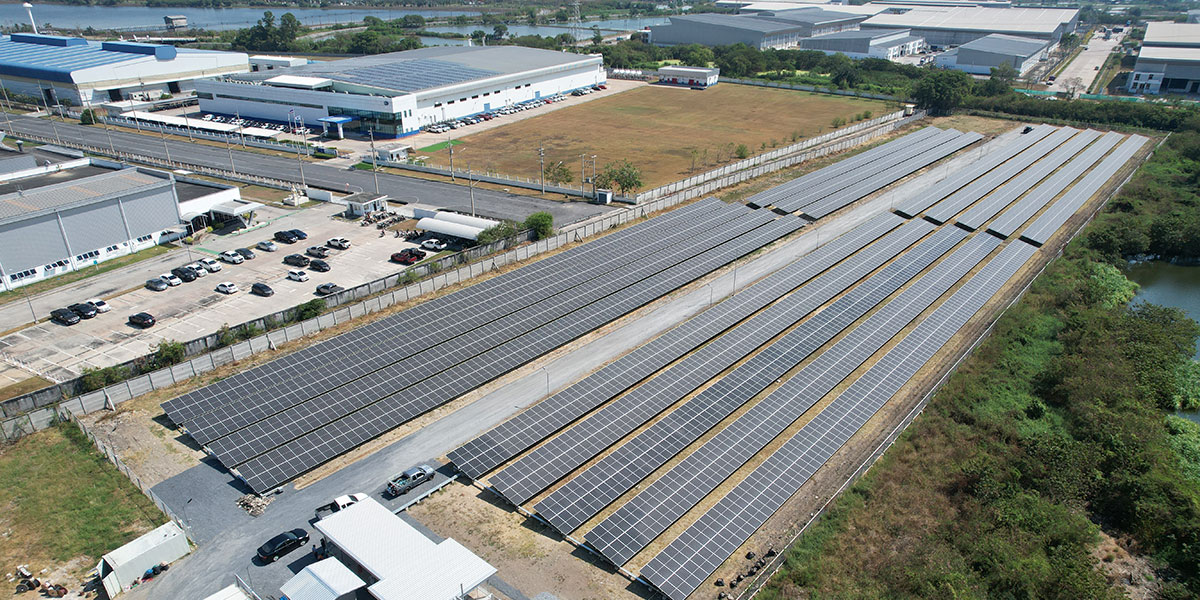
SCG establishes a new company to enter the solar energy industry. (Photo: SCG Cleanergy)
The Asia Low Emission Strategic Partnership (ALP) recently held its annual exchange forum in Taiwan, where Thailand’s Siam Cement Group (SCG) shared insights on finding new investment directions in the sustainable decarbonization process.
Additionally, an analyst from the ASEAN Centre for Energy (ACE) emphasized that the development of renewable energy in ASEAN largely depends on regional grid and digital transformation.
Thailand's low-carbon city: role of the cement industry
ALP was established in 2012 as a regional organization promoting low-carbon development across Asia. It is part of the Global Climate Action network, alongside regional platforms in Africa and Latin America. The partnership hosts an annual exchange forum. Taiwan joined in 2018 under the Ministry of Economic Affairs, establishing a cross-ministerial task force to implement relevant initiatives.
Jetapon Aimmanee, the Director of Net Zero Transition at Siam Cement Group, discussed the decarbonization roadmap established by the Thai Cement Manufacturers Association (TCMA), which includes seven key indicators. Notably, Carbon Capture, Utilization, and Storage (CCUS) is expected to become a critical technology for reducing emissions in clinker production after 2030, contributing up to 45% to net-zero efforts by 2050.

Jetapon Aimmanee shares Thailand's net-zero initiatives. (Photo: Lin Bo-yu)
The Saraburi Sandbox initiative, jointly launched by TCMA and other organizations, represents Thailand’s first industrial cluster that balances economic growth with decarbonization. In September, it became the first Thai project to join the World Economic Forum’s Transitioning Industrial Clusters Initiative, with Siam Cement playing a leading role.
Jetapon noted that Saraburi is Thailand’s largest cement production hub, accounting for 80% of the country’s cement capacity, and it has a clear net-zero blueprint for 2050. The initiative’s success is attributed to a public-private-people partnership model, positioning it as the foundation for Thailand’s first low-carbon city.
In terms of products, Siam Cement continues to roll out low-carbon cement, anticipating a 40% to 50% reduction in carbon emissions from new products by 2026. The penetration rate of low-carbon cement in Thailand reached nearly 81% by the fourth quarter of last year and is expected to hit 100% in 2024. Jetapon emphasized that this high penetration rate is a collective effort, not just the work of Siam Cement alone.
Siam Cement aims to reduce Scope 1 and Scope 2 emissions by 20% from a 2020 baseline by 2030, with a long-term target of achieving net-zero emissions by 2050. In addition to decarbonizing its core operations, Siam Cement is creating new business opportunities, such as establishing a clean energy company focused on developing rooftop solar systems.
Key factors in ASEAN's energy transition: digitalization, power grid
With economic growth driving electricity demand, the ASEAN Centre for Energy estimates that the region’s electricity demand will increase 2.6 times by 2050 compared to 2022. To implement energy transformation, the digitalization of electricity systems is essential for meeting supply and demand more intelligently and securely, enhancing connectivity for improved energy efficiency, and facilitating the integration of renewable energy.

Rika Safirna discusses the value chain of energy digitalization in ASEAN countries. (Photo: Lin Bo-yu)
Using the ASEAN Power Grid (APG) to promote renewable energy development is part of the digital strategy outlined in the ASEAN Plan of Action for Energy Cooperation (APAEC). Rika Safirna, a senior analyst at ACE, pointed out that emerging technologies such as energy storage, machine learning, and blockchain have transformed the ways in which electricity is produced and transmitted. By connecting regional power grids, these advancements enable more flexible management of solar and wind energy, thereby increasing the prevalence of renewable energy sources.
Analysts recommend that ASEAN countries approach the digitalization of their electricity systems by focusing on three key areas: developing comprehensive plans, building infrastructure, and enhancing personnel and organizational capacities. She also emphasized the importance of establishing standards, setting goals, and fostering a culture of innovation through a technological lens, ensuring energy security, affordability, and sustainable development.



